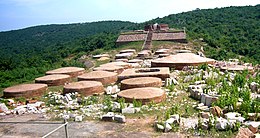శాలంకాయనులు
| అధికార భాషలు | ప్రాకృతం సంస్కృతం తెలుగు |
| రాజధానులు | వేంగి |
| ప్రభుత్వం | రాచరికం |
| శాలంకాయనులకు ముందు పాలించినవారు | శాతవాహనులుఇక్ష్వాకులు |
| శాలంకాయనులకు తర్వాత పాలించినవారు | పల్లవులు |
శాలంకాయనులు - సా.శ. 300 - 420 మధ్యకాలం - వేంగినగరం వారి రాజధాని. వేంగి రాజధానిగా పరిపాలించినట్లుగా స్పష్టమైన ఆధారాలతో (ఏలూరు శాసనం ద్వారా) తెలియవస్తున్న మొదటి రాజులు శాలంకాయనులు. "శాలంకాయన" అనేది గోత్రనామమని, వంశం పేరు కాదని తెలుస్తున్నందువలన చరిత్రకారులు వీరిని వర్ణించడానికి "వైంగేయికులు" అనే పదాన్ని వాడుతున్నారు. సముద్రగుప్తుని అలహాబాదు ప్రశస్తిలో కూడా "వైంగేయక" అనే చెప్పబడింది.[1]. వీరిలో హస్తివర్మ సముద్రగుప్తుని సమకాలికుడు.1వ మహేంద్రవర్మ అశ్వమేధయాగం చేశాడని అంటారు. శాలంకాయనులు పాటించిన చిత్రరధస్వామి (సూర్యుడు) భక్తికి చెందిన ఆలయము యొక్క శిథిలాలు పెదవేగిలో బయల్పడ్డాయి.[2][3] శాలంకాయనులు "చిత్రరధస్వామి"ని పూజించినట్లు తెలుస్తున్నది (భగవత్ చిత్రరధస్వామి పాదానుధ్యాతః). ఈ చిత్ర రధ స్వామి శివుని రూపమో, విష్ణువు రూపమో, లేక సూర్యుని రూపమో తెలియడం లేదు.[4]
పాలకులు
మార్చు- హస్తివర్మ
- నందివర్మ
- విజయదేవవర్మ
- విజయనందివర్మ
చారిత్రక ఆధారాలు
మార్చు"మైసోలియా" (కృష్ణా తీర ప్రాంతం) లో "బెన్గొరా" (వేంగీపురం) చెంత "సాలెంకీనాయ్" (శాలంకాయనులు) ఉన్నట్లు గ్రీకు చరిత్ర కారుడు టాలెమీ సా.శ.130లో వ్రాశాడు.[5] అయితే ఆ బెన్గొరా (Bengaouron) అనేది వేంగీపురం కాదని కొందరు చారిత్రికుల అభిప్రాయం.[6] ఏలూరు, పెదవేగి, గుంటుపల్లె, కానుకొల్లు, కొల్లేరు, కంతేరు, పెనుగొండ వంటి వివిధ శాసనాల ద్వారా శాలంకాయనుల గురించి కొన్ని వివరాలు తెలుస్తున్నాయి.
శాలంకాయనుల స్వతంత్రాధికారాన్ని హస్తివర్మ సా.శ.320లో స్థాపించి ఉండవచ్చును. వివిధ శాసనాలలో ఇతనిని "నానాప్రకార విజయస్య" (గుంటుపల్లి), "అనేక సమరావాప్త విజయ" (పెదవేగి), "సమరముఖ నిర్మాత కర్మ" (కానుకొల్లు), "ధర్మమహారాజ" (గుంటుపల్లి) అనే బిరుదులతో వర్ణించారు.[7] ఈ వర్ణనలను బట్టి ఇతడు వేంగి ప్రాంతంలో సామంతులను జయించి రాజ్యాన్ని స్థిరపరచాడని భావించవచ్చును. ఇతడు సముద్ర గుప్తుని సమకాలీనుడు.
హస్తివర్మ కుమారుడు నందివర్మ (350-385). ఇతడు తిరుగుబాటుదారులను అణచివేసి కృష్ణానది దక్షిణానికి కూడా వేంగి రాజ్యాన్ని విస్తరింపజేశాడు. ఇతడు ధార్మిక చింతనపరుడు. "వివిధధర్మ ప్రధానస్య" అని పెదవేగి శాసనంలోను (కనుక వారు బౌద్ధ, వైదిక ధర్మాలను రెంటినీ ఆదరించినట్లు తెలుస్తున్నది), "ఆర్జిత ధర్మ ప్రదానస్య, గీసహస్రదాయి" అని గుంటుపల్లి శాసనంలోను వర్ణింపబడ్డాడు. ఇతని తరువాత ఇతని తమ్ముడు దేవవర్మ, కొడుకు అచండవర్మల మధ్య అధికారం కోసం అంతర్యుద్ధం జరగడం వలన శాలంకాయనుల ప్రతిష్ఠ దిగజారింది. అంతే గాకుండా ఉత్తరాన పిష్ఠపురం (పిఠాపురం) లో మాఠరులు, దక్షిణాన కర్మరాష్ట్రంలో బలవంతులై శాలంకాయనులతో పోరాడసాగారు. సా.శ.5వ శతాబ్ది ప్రాంతంలో శాలంకాయనుల రాజ్యం అస్తమించింది. వారిలో చివరిరాజు విజయనందివర్మ గుంటుపల్లిలోని బౌద్ధ క్షేత్రానికి దానధర్మాలు చేశాడు.
శాలంకాయనులకు ఇంచుమించు సమకాలికులుగా కృష్ణానది దక్షిణాన కర్మరాష్ట్రాన్ని ఆనందగోత్రిజులు పాలించారు. కళింగాంధ్ర (ఉత్తరాంధ్ర) ప్రాంతం 'సింహపురి' (శ్రీకాకుళం వద్దనున్న సింగపురం) రాజధానిగా కళింగులు, తరువాత మాఠరులు పాళించారు. ఉత్తరాన పిష్ఠపురం ప్రాంతాన్ని కొంతకాలం కళింగులు, తరువాత మాఠరులు, తరువాత వాసిష్ఠులు పాలించారు.
మూలాలు
మార్చు- ↑ Early_History_Of_The_Andhra_Country by K. Gopalachari, published by University_Of_Madras, (Research work in 1941)
- ↑ D. R. Bhandarkar Volume By Devadatta Ramakrishna Bhandarkar, Bimala Churn Law పేజీ.216 [1]
- ↑ Sculptural Heritage of Andhradesa By Mohan Lal Nigam పేజీ.35
- ↑ Excerpts from Dr.Gopalachari Thesis: The tutelary deity of the Vaingeyakas was Citrarathasvami ("bhagavat Citraraihasvami padanudhyatah"). Sanskrit Lexicons give Citraratha as the name of the sun, the vahana of Agni and some princes. K. V. Lakshmana Rao thinks that Citrarathasvamin is the Sun-God. While editing the Ellore plates of Devavarman, Dr. Hultzsch referred to the existence of a mound "which, on a visit to Pedda-Vegi in 1902, was shown to me by the villagers as the site of the ancient temple of Citrarathasvamin, the family deity of the Salankayana Maharajas." .... It is, therefore, possible that the Vaingeyikas, some of whom had Saivan and others Vaishnava leanings were at the same time worshippers of the Sun- God also. ... Sriparvatasvami (i.e., the god worshipped in Sriparvata in the Visnukundin inscriptions), cannot Citmrathasvdmi mean the god worshipped in Citraratha ? We do not know of any place called Citraratha. Nor do the Pallava records throw any light on this question.
- ↑ The Ancient City of Vengipura : Archaeological Excavations at Peddavegi/I.K. Sarma. Delhi, Book India Publishing Co., 2002, ISBN 81-85638-15-2. https://www.vedamsbooks.com/cgi-bin/main.cgi?no31025.htm[permanent dead link] - Infact Ptolemy (140 A.D.), refers to Vengi as the capital city of the Salankayanas.
- ↑ Excerpt from Gopalachari's thesis: The attempts of some scholars to see in Salankayana the name of a people, becoming subsequently the name of a dynasty also, is wasted effort . Dr . Rayachaudhuri has identified the ' Salakenoi ' of Ptolemy with the 'Salankayanas ' of Vengl.14 D. C. Sircar accepts this identification15 and adds : "It has been noticed that the terms Salankayana and Salankayanaka (country of the Salankayanas) are mentioned in the Ganapatha of Panini. It is certain that the Salankayanas (Greek Salakenoi) ruled over the Vengl region as early as the time of Ptolemy (c, 140 A.D.)." He would further consider Benagouron as a mistake for Bengaouron which would represent Vengipura. Having regard to the fact that in Ptolemy's Book the n sound is not suppressed e.g. Gangaridai (Book VII, Chapter 1, Section 81) and Peririgkarei (Section 89), Salakenoi can be rendered Salakana and not Salahkayana. The Salakenoi are placed north of the river Manadas which is almost certainly the Mahanadi, the great river of Orissa, far north of the Andhradesa of literature. Kings of the Salarikayana gotra ruled over the heart of the Andhradesa and the suggestion of some scholars that they ruled over Kalihga and Magadha (!) lacks proof; and Ptolemy's description of the eastern part of the peninsula is not as much vitiated by errors as that of the western and southern parts. The Sdlankdyanaka of Panini does not mean ' the Country of the Salankayanas '; it is the adjectival form of Salatikayana which belongs to the Rdjanyddi class. Names like Athenogouron make it highly improbable that Benagouron is a mistake for Bengaouron. Benagouron would correspond to Benanagara ; and as several Benas are known, and the Benagouron of Ptolemy is on the banks of a river, a Benanagara is not impossible. The Benagouron of Ptolemy is not called a metropolis, while Vengipura was certainly the capital of the kings of the Salankayana gotra.
- ↑ ఆంధ్రుల చరిత్ర - డా.బి.ఎస్.ఎల్. హనుమంతరావు (విశాలాంధ్ర పబ్లిషింగ్ హౌస్)
